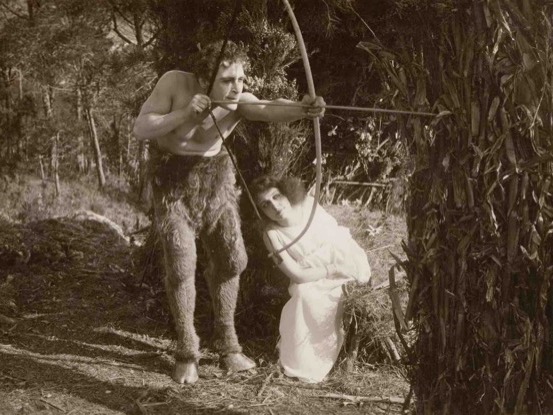FAUNO
Febo Mari (IT 1917)
With a successful stage career already behind him, after his debut with Ambrosio in 1912 Febo Mari divided his time between that production company and Itala Film, both as an actor and an auteur (director, and writer of stories and screenplays), finally becoming a producer with the formation of Mari Film in 1918. His name can be found credited in various capacities on some of the most interesting Italian silent film productions of the 1910s: Il fuoco (1915), Cenere (1916), Tigre reale (1916), and Fauno (1917). If in his early theatre career he was already close to the philosophy of Gabriele D’Annunzio, this film marks the maturity of his own very personal idea of art, both behind and in front of the camera. In this context, Fauno stands as Mari’s most courageous and elaborate work.
A sculptor, who lives with his young model, has produced a statue of a faun (made especially for the film by Giovanni Riva, with Mari as his model), a mythological creature, half-man and half-goat. The life-size sculpture dominates the interior of the studio, and with its silent allure it is at the centre of the stories and characters revolving around it. A head unblemished by two tiny horns, and a splendid torso – like the divo he was, Mari gives life to every metamorphosis from stone to flesh with powerful sensuality, in a fine balance above the hairy bestiality of his grotesque lower body.
One evening the sculptor goes out, leaving his model alone, apprehensive and fearful. At ten o’clock she falls asleep on the studio sofa; upon awakening she looks in the sculptor’s jacket and finds a note from his lover. The statue of the faun, a symbol of nature and primordial love, comes to life and consoles the girl: “Do not be hurt. From the heart down all men are like me – beasts.”
Meanwhile, in a smart gambling den, where the players at the tables symbolize vice, enters the sculptor, awaited by his lover and her husband the prince. There the crafty couple cheat him out of his money; unable to pay his debt, he promises them one of his statues. The princess comes to the studio and encounters the model. The two women size each other up until the femme fatale decides to take the faun, since it evidently means a great deal to the girl. A team of porters comes to take the statue away but on the journey it falls from the cart. As it does so, it comes to life, and flees with the model, who has been following it. Together they enjoy a brief idyll in a wood, where they build a hut and eat the fruits of the earth in perfect harmony with the nature surrounding them. The sculptor finds them and is confronted by the faun, who bests him but is treacherously shot with a rifle by his jealous rival. The faun turns again to stone, and the statue is taken to the prince’s palace.
The inconsolable model tries in vain to persuade the prince and his wife, her rival, to take another of the sculptor’s statues instead of the faun. The wife contemptuously refuses, and the girl – after a last farewell from the faun, who comes to life one more time just for her – falls in desperation at the statue’s feet, as if dead. A power attributed to the faun, from ancient texts to the most up-to-date fantasy genre in which the sylvan figure recurs, is that of generating dreams and nightmares… The young model wakes up in the studio, and just one hour has passed; the statue is there, smiling and immobile on its pedestal.
One of the film’s defining characteristics is the presence of an eroticism explicit in the game of seduction, in the contact between the girl and the faun – now flesh, now stone – which from the start of their fleeting bucolic idyll is revealed to be an impossible desire. Complicit in the creation of this atmosphere are the juxtaposition of shots, the camera movements, and the almost choreographic interplay between the actors, but above all the refinement in its use of light, with the combination of tinting and toning – still one of the film’s most remarkable features. According to Paolo Cherchi Usai, describing the restoration of the film in 1994, Fauno “is first of all one of the most striking colour films passed down from the silent era as painting in movement… Inherited as the product of luministic perfectionism, or as a gift of chance, this small precious stone stands as a fragile pictorial jewel of symbolism”.
Unforgettable are the shots of the faun’s first encounter with the girl, in the glare of the flames burning in the hearth, and the dialogue in some of the intertitles: “Do not run from me. I am love.”
Claudia Gianetto

regia/dir, sogg/story, scen: Febo Mari.
photog: Giuseppe Vitrotti.
cast: Febo Mari (Il Mito, il fauno/the Myth, the faun), Antonietta (Nietta) Mordeglia (Fede, la modella/the model), Vasco Creti (Arte, lo scultore Mariotti/the sculptor), Elena Makowska (Femmina, la principessa Mierbo/the princess), Oreste Bilancia (Astuzia, il principe Mierbo/the prince), Ercole Vaser (carrettiere/the carter), Umberto Scalpellini (un giocatore/a gambler).
prod: Ambrosio, Torino.
v.c./censor date: 21.05.1917 (n. 12769).
copia/copy: 35mm, 1428 m., 69’35” (18 fps), col. (imbibito e virato/tinted & toned); did./titles: ITA.
fonte/source: La Cinémathèque royale de Belgique, Brussels.
Restauro/Restored: 1994, La Cinémathèque royale de Belgique, Museo Nazionale del Cinema, La Cineteca del Friuli, con fondi del/with funding from The LUMIERE Project (MEDIA Programme)


 Italiano
Italiano